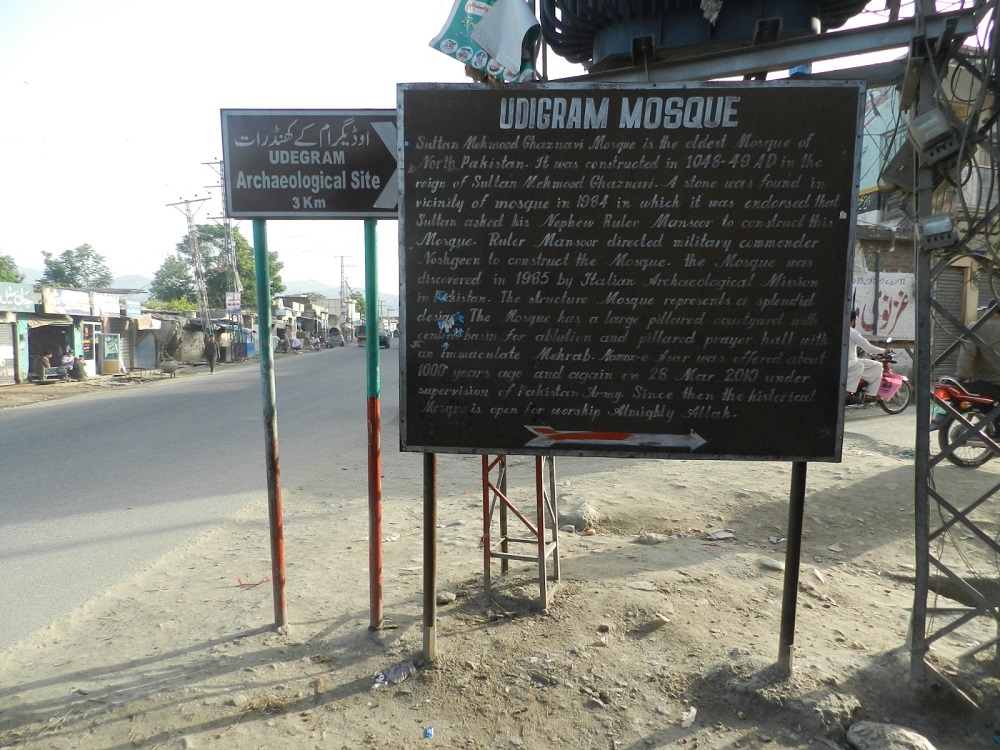Written by: Sirat Gohar Daudpoto
Posted on: October 12, 2023 |  | 中文
| 中文
Courtyard with water tank (foreground) and prayer hall with visible pillar bases, mihrab and qibla wall (background) of the Udegram Mosque
Many of the country’s mosques are hundreds of years old, and the earliest of them dates to the early 8th century CE, showing the long history of Islam in Pakistan and the Islamization of the region. Wherever there is a Muslim settlement there is a mosque, hence, they are found in every nook and cranny of the country.
The three oldest mosques in Pakistan are located in Bhambhore, Mansura and Udegram. Two of these mosques, Bhambhore and Mansura, are in the Sindh province, and the Udegram mosque is situated in the Swat district of the Khyber Pakhtunkhwa province of Pakistan. The Udegram mosque is the third oldest mosque in the country dating to the 11th century CE, but after the ancient mosques at Bhambhore and Mansura, which were built in the 8th and 9th centuries CE respectively. Located at a distance of about 3 kilometers from Udegram/Odigram town on the main Barikot-Mingora Road in Swat, the Udegram mosque is built on the slope of a mountain, which is called Mount Raja Gira after a king named Raja Gira, who owned a palace/castle the remains of that can be seen on the mountain.
This mosque was built during the Ghaznavid occupation of the region. An Arabic inscription that was found in 1984 by a villager at the site, mentions the date 440 AH (1048-1049 CE) of the construction of the mosque. The translation of the inscription provided in Muhammad Nazir Khan’s article with the title, A Ghaznavid Historical Inscription from Udegram, Swat, is as follows:

Signboards installed on the main Barikot-Mingora Road containing information on the Udegram Mosque and showing the site's direction
Based on this evidence, many scholars suggest that the mosque was built in that year. On the contrary, thanks to the excavations carried out by the Italian Archaeological Mission at the site, the archaeological evidence shows that the mosque was constructed in the early 11th century CE. It is likely that the inscription refers to the later construction work at the mosque.
Udegram mosque is constructed in the center of the terrace built on the northern slopes of the mountain. Built with slabs and blocks of schist in a later style of the locally used ‘Gandharan’ masonry technique. According to Alessandra Bagnera, who writes in The Ghaznavid Mosque and the Islamic Settlement at Mt. Raja Gira, it is rectangular in plan measuring 28 x 21 meters with two entrances to the east (main entrance) and west, hypostyle prayer hall, courtyard with a central basin, square mihrab, minbar, and three attached rooms to the north side. On both sides, east and west of the mosque, several other structures, which include dwellings and tombs belonging to Muslims have also been discovered, indicating the existence of a larger Muslim community in the area. The remains of the minbar to the right side of the mihrab show that it was a jami mosque, and this also points to the Muslim settlements in the surroundings of the mosque.
You may also like: